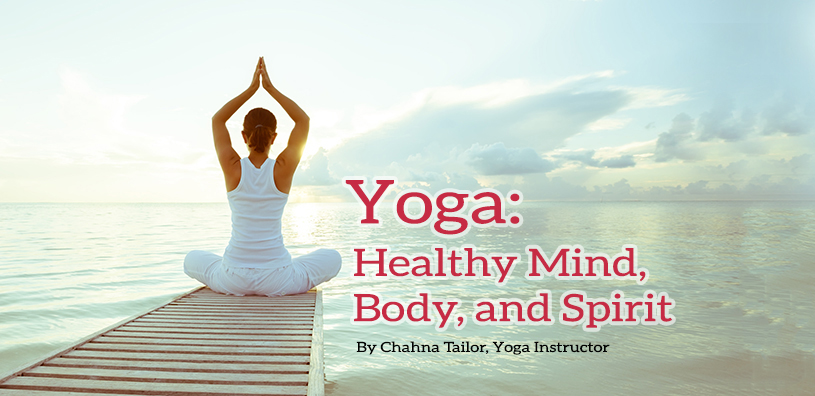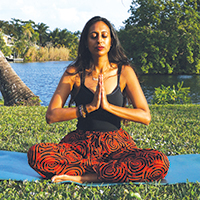Yoga: Healthy Mind, Body, and Spirit
 |
|
For thousands of years, utilizing purifying practices such as asanas (physical poses), pranayama (control of the life force energy), and dhyana (meditation) were nothing out of the ordinary in India. It was common knowledge that these practices were beneficial for mental, physical, and spiritual health. However, in today’s day and age, these ancient teachings are being pushed to the side due to the misconception that these practices are not applicable to our daily lives. In reality, it is quite fascinating how far that is from the truth.
When we devote an extended period of time in the same sitting position, a variety of things happen. Muscles in the legs start to lose their strength, the blood does not circulate efficiently, and we put a lot of weight on our hips and pelvis. Unless we are consistent with employing proper body mechanics, we also tend to hunch causing additional strain on the neck, shoulders, and back as well as limit our ability to take in sufficient oxygen. Moreover, the stress from trying to maintain a healthy work/family/recreational life balance can also impact our body systems in different ways. It can start with something as minuscule as indigestion or a headache. At first, we ignore it – thinking it’s just a routine and insignificant dip in our immune system that will go away in a few days. Sometimes, we attribute it to the aging process and accept is as part of life. In reality, this is just the beginning of energy blockages. Without giving these energy blockages the proper attention and treatment they deserve, these minor functional defects can become chronic, resulting in malfunction or failure of a bone, limb, organ, or an entire system within the body. For these reasons, we can actually utilize yogic practices as preventative measures or as a way of coping with existing stresses by releasing energy blockages. Yoga asana poses lessen tension in the body, pranayama breathing exercises stabilize the nervous system, and practice of dhyana (meditation), helps one live in the present moment, develop mindfulness and cultivate stillness. It may be hard to believe, but there is an asana that will address issues with the circulatory, digestive, excretory, endocrine, lymphatic (immune), nervous, and/or muscular system just by performing it! Even though the goal was to sit in meditation for long periods in order to achieve self-realization, asanas were used as a way to increase the body’s tolerance to sitting motionless without having any physical or mental distractions. Even today, if we are sitting at a desk working for long hours, we are much more effective if we have no aches, pains, or mental distractions. Each pranayama technique can provide a different benefit. Certain practices are used to quiet the mind and decrease anxiety and stress, some can heat up or cool down the body’s temperature, whereas others are specifically used to increase the flow of oxygen in the body and purify the energy channels. A true yogi is not marked by his/her ability to perform a split or a handstand, but by the ability to maintain a constant breath throughout their life practice. Asana and pranayama are important to instilling a meditation, or one-pointed concentration, practice. They are considered the stepping stones. In some aspects, when you take a yoga class today, the cultural and spiritual aspects have been eradicated. Yoga is a way to heal yourself, so it cannot be compared to exercise. It is medicinal and encompasses a comprehensive way of life. Today, yoga is marketable, trendy, and the majority of the yoga classes and even yoga teacher trainings are not in line with real yogic teaching; they can be diluted and commercialized. In the West, yoga teacher trainings mainly focus on the asanas – but, that is only one of the eight limbs of yoga! The other seven limbs are equally important. When I received my yoga teacher training in the yoga capital of the world, Rishikesh, India, there was a holistic focus on all eight limbs of yoga as well as yoga philosophy, Ayurveda (which included cooking!), mudras, bandhas, and even the science of breath. They understand how every subject is connected and that each aspect has a specific purpose. The yoga teachers made sure they were teaching yoga classes, not asana classes. When attending a yoga class or even practicing yoga on your own, it is important that you are receiving more than just physical benefits from your practice. Yoga is not an exercise regime, even though that is what has been instilled in the minds of the masses. If you think health is just physical, you’re missing the picture. We should keep the mind andspirit healthy as well! In this busy world that we live in, we spend the majority of our time connecting/interacting with others, whether it is face to face or through technology. But, how often do we take time to connect with ourselves? By creating an awareness on our body, breath, and thoughts, we can achieve physical, mental, and spiritual bliss, or samadhi. |
|
Chahna Tailor is a certified yoga instructor with backgrounds in occupational therapy and health science. Occupational therapy opened up the doors of knowledge when it came to taking care of the Self first and leading a healthier life. This led her to the physical practice of yoga. Chahna deepened her practice by training in Rishikesh, India, where she studied the science behind yoga, the breath, and meditation. Chahna also practices personal training, Reiki, hypnotherapy, aromatherapy, pranichealing, and sound healing. |



 Even though the main reason for sitting down was different for a yogi, a yoga practice actually mirrors our life. A yogi spent many hours sitting in meditation without changing the position of his body. If you reflect on how many of us spend the hours of our day, you will realize that you tend to spend much of the time sitting down.
Even though the main reason for sitting down was different for a yogi, a yoga practice actually mirrors our life. A yogi spent many hours sitting in meditation without changing the position of his body. If you reflect on how many of us spend the hours of our day, you will realize that you tend to spend much of the time sitting down.  About the Author
About the Author























